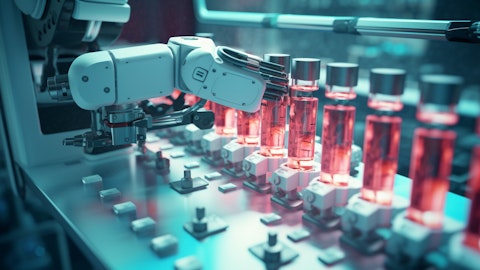Aaron Rakers: Thank you.
Operator: Thank you. One moment for our next question. And our next question comes from the line of C.J. Muse from Cantor Fitzgerald. Your question, please.
C.J. Muse: Yes, good afternoon, thanks for taking the question. I guess, Sanjay, would love to hear your thoughts around wafer movement from Big 3 to HBM and what impact that’s having on the supply-demand outlook for DDR5 and sort of any context around customer engagement and longer-term contracts? And then more on the gross margin side, you’ve talked about the inventory previously written down, now behind us. Can you walk through the moving parts that should dictate what we’ll see in gross margins throughout the remainder of calendar ’24? Thanks so much.
Sanjay Mehrotra: So on your questions regarding wafers shift to HBM, as we have highlighted that HBM — HBM3E needs three times more wafers than nearly three times more wafers than DDR5 in the same technology node of the same capacity to produce the same bits. So this is of course highly silicon intensive technology and this factor of three has the trade ratio between HBM and D5 is really common across the industry. So what — and HBM demand is increasing rapidly, you see all the recent announcements that are only showing you that even greater attach rate of HBM to the latest GPU solutions that were just announced earlier this week. 192 gigabyte in the Blackwell platforms versus the 144 gigabyte. And of course, this is a phenomenon that’s occurring across the Board.
Even today, I think, Broadcom talked about how HBM content is going to further increase. So HBM is in a high-demand growth phase and this demand growth will continue in terms of bits, in terms of revenue over the course of the foreseeable future. And this is putting tremendous pressure on the non-HBM supply. The trade ratio of three to one, increasing demand in HBM, increasing — increased profitability of HBM is putting non-HBM part of the memory in tight supply. This is why we say that leading-edge nodes are in very tight supply. And as a result, we would fully expect that D5, as well as other DDR products will improve in their profitability picture as well, given their very much tight supply there. And of course, HBM being in a strong position.
When you look at the LTAs, we have talked to you about our supply already being locked up for ’24 and ’25, and this then increases our confidence in our D5 as well as LP5 — LPA positions with the customers.
Mark Murphy: And good afternoon, C.J., it’s Mark. On the gross margin side, as you mentioned it’s been a tough year, plus year and a half on a lot of timing differences, difficult to gauge the cost downs and gross margin progression underutilization effects, lower node transitions, structural capacity-reduction and so forth that we’re contributing to the weaker cost downs. And as you mentioned, the lower the written-down inventories, finally cleared in the second quarter. It was a bit of a headwind to actually in the sense that, it was less of a benefit than the first quarter. So, but still, nonetheless it was a favorable benefit that we will market in the third quarter. And then the period costs also reduced from first to second quarter.
So, we’re now under $50 million on period costs related to underutilization. As I mentioned in my comments that’s legacy-related capacity now only and that would continue going forward. So now we see more normal conditions on cost downs and related margin effects. We see node transitions occurring. Those are positive. The underutilization effects are fading away, as we mentioned. We’re getting volume leverage and the associated absorption and then just the business being able to focus on efficiency. So as we mentioned before, we’re now in the front end would expect mid to high-single-digit cost downs as normal. I think that as you look forward, and Sanjay alluded to this, you will begin to see the costs related to HBM weigh on our cost down performance.
Now it’s a good trade, of course, because the mix is favorable, the price is higher on those products. So it’s an accretive margin trade, but that will impact the cost downs.
C.J. Muse: Very helpful. Thank you.
Operator: Thank you. One moment for our next question. And our next question comes from the line of Timothy Arcuri from UBS. Your question please.
Timothy Arcuri: Thanks a lot. Sanjay, I had a question just around the tenor of the discussions that you’re having with your customers. I mean the industry is bigger this year in terms of bits. It sounds like mostly due to a higher baseline coming off last year. But it sounds like supply hasn’t really increased to match that higher bits this year. So the balance has gotten even tighter over the past three months. So how has that changed the dynamics of your discussions with your customers? I know you had a $600 million prepay last quarter. Did you get any prepays this quarter? Are you talking about new sort of contract structures with customers where they maybe fund some of your CapEx? Can you kind of talk about all that? Thanks.
Sanjay Mehrotra: So just keep in mind that in fiscal year ’24 or calendar ’24 versus ’23, the shipments will increase substantially. And as you noted, I mean, the year-over-year increase in shipments will be substantial. And as you noted, the supply is very tight. Supply is tight due to the factors that we have discussed before. Due to the downturn that the industry experienced last year, CapEx cuts were made, utilization cuts were made, structural shift from traditional older nodes to newer nodes of equipment was made in order to support the leading-edge nodes. And that resulted in a structural reduction in wafer capacity in the industry as well. And then there is the HBM factor, the trade ratio 3:1 that I have discussed today.





